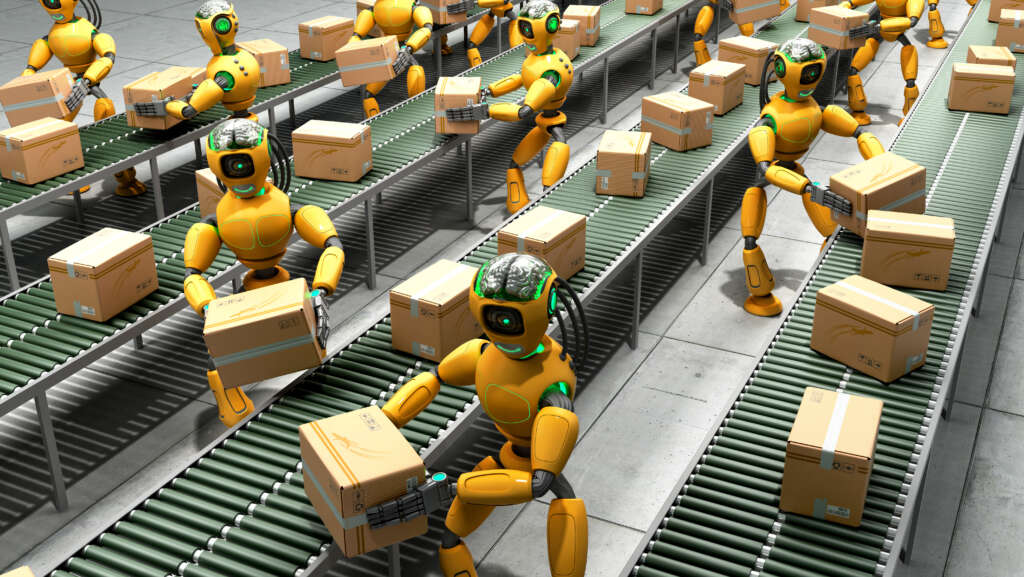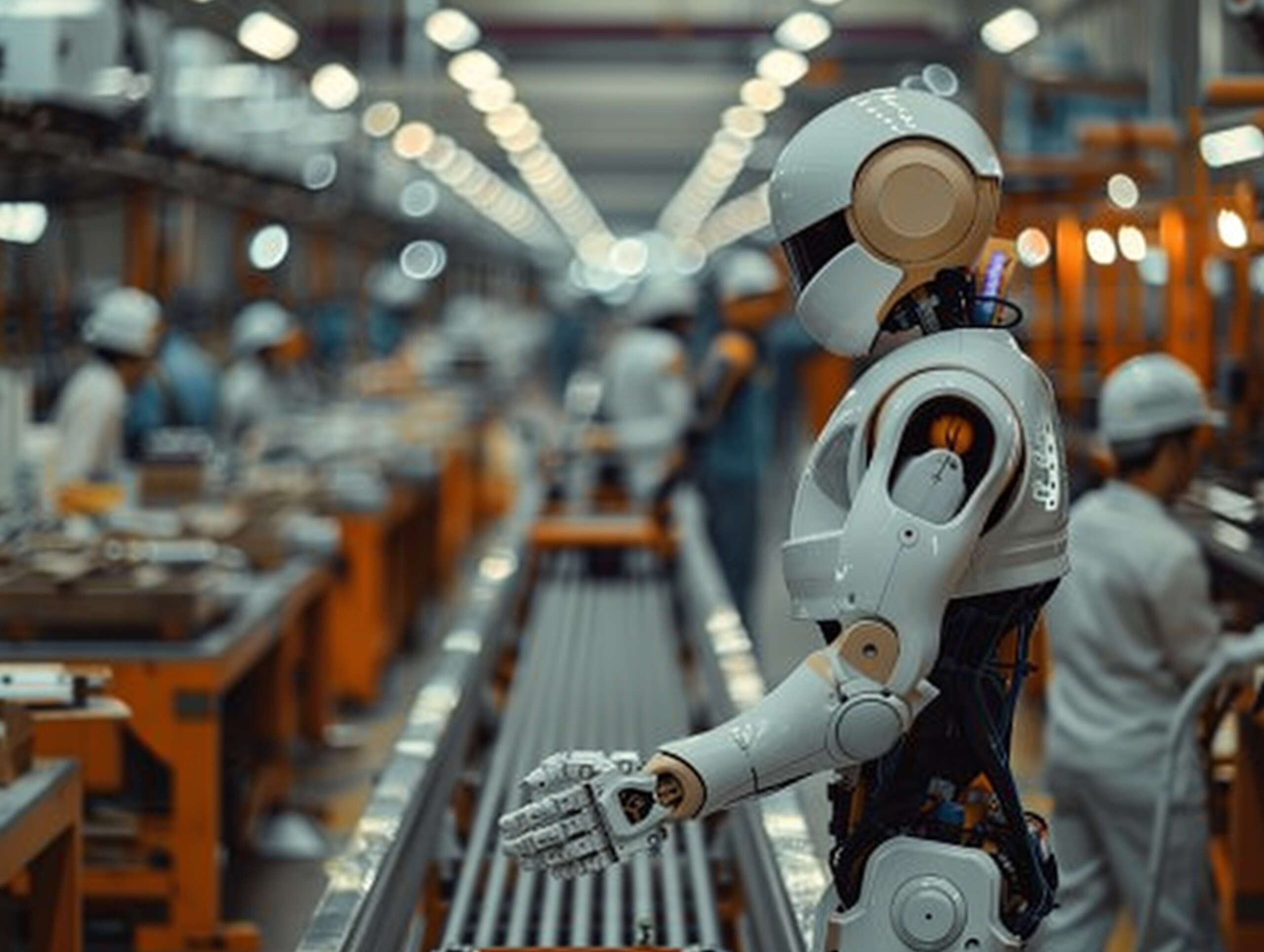Imagine a world where making things run smoothly is key and every choice helps you stay ahead. In the drive for top-notch business, has artificial intelligence (AI) become essential for making things run better? AI in Operations is changing the game, letting companies dream big and do things once thought impossible.
In this AI age, the business world is changing fast. AI for operational efficiency uses machine learning to make things better and even beat old methods. Now, tools like natural language processing and computer vision are key players, making communication and decision-making better. These tools help businesses use predictive analytics, moving away from just reacting to problems.
At the heart of AI’s big change is making decisions based on data. Companies use AI to quickly and accurately go through huge amounts of data. AI solutions grow with businesses and offer flexibility. They help improve customer service with chatbots and change manufacturing with predictive maintenance, making AI key for modern business.
But, there’s a catch: we might be focusing too much on trends and not enough on our data to make big decisions. Skylytics uses Neo4j Graph Data Science (GDS) to spot risks in supply chains, showing a move towards smarter, data-focused decisions. This series will look at how AI is changing streamlining business processes with AI and making us question our old ideas about making things run smoothly.
Key Components: How AI Transforms Business Efficiency

AI-powered operations have changed how businesses work. They use machine learning, natural language processing, and computer vision. These tools help AI systems automate tasks, learn from results, and understand human language. They also analyze data to make smart decisions, which is key to improving business efficiency.
Businesses have seen big changes with operational AI tools. For example, machine learning helps in cybersecurity, digital assistants, and CRM systems. It automates and improves processes, making customer interactions more personal and managing relationships better.
Deep learning, a part of machine learning, is crucial for detailed analysis and prediction. It’s used in fraud detection and identifying defects in manufacturing. Discover AI’s role in transforming finance with such precision. Companies like IBM and Electrolux have become more agile, achieving high order fulfillment rates and reducing IT issue times.
AI quickly analyzes big data, helping businesses respond fast and accurately to market demands. This leads to better decision-making, especially in supply chain management. It reduces forecasting errors and inventory issues, making operations smoother and customers happier.
In conclusion, adding AI to business systems does more than just automate tasks. It brings predictive analytics, smart data processing, and real-time decision-making. This change is key to how businesses operate and succeed in today’s digital world. Investing in AI-powered operations is essential for staying competitive and efficient.
The Impact of AI in Operations on Supply Chain Management
AI is changing how businesses handle logistics and manage their stock. It uses deep data insights for quicker, smarter decisions. This isn’t just about making things run faster; it’s about making them better and more reliable.

AI in process automation has changed how supply chains predict demand and manage stock. It looks at many factors to guess what people will want next. This helps companies avoid having too much or too little stock. For example, Google’s Video AI spots early signs of demand spikes, helping companies adjust their stock levels.
AI also helps with planning routes and managing logistics, which are key for on-time deliveries. It looks at traffic, weather, and how vehicles are doing to find the best routes. This makes deliveries faster and cheaper.
The Obama administration focused on making AI in supply chains more secure. They put money into making these systems stronger. This means AI helps with both making things run better and keeping supply chains safe and stable. Thanks to this, delivery times have gotten 65% faster.
But, there are still challenges, like not knowing what’s happening in the deeper parts of supply chains. Only a few companies know what’s going on beyond their first suppliers. AI in process automation helps by giving insights into the second and third tiers of suppliers. This reduces risks and makes supply chain management stronger.
The use of AI in supply chains not only makes things run better but also makes them more responsive. This makes networks more adaptable and resilient to changes in the market.
Optimizing Logistic Efficiency with AI-Powered Solutions
The use of AI in Operations is changing how we manage logistics. It brings new levels of efficiency and accuracy. AI algorithms predict the best routes and schedules, taking into account traffic, weather, and rules. This helps keep operations smooth and ensures deliveries are on time.

UPS’s ORION system is a great example of how AI boosts efficiency. It saves millions of miles and gallons of fuel each year by optimizing routes. DHL uses AI to stack containers better, which saves space and cuts costs.
AI does more than just optimize routes; it changes how we maintain fleets. It helps monitor vehicle performance and fuel use, making fleets safer and more efficient.
Geotab and Samsara are leading the way with AI in fleet management. They predict when maintenance is needed and keep an eye on how well vehicles perform. Cargill uses AI to improve farming operations, like estimating broiler weights and planning harvests better.
The impact of AI in Operations began over a decade ago. It started automating tasks like routing and dispatch. Since then, AI has cut costs and made deliveries faster. It makes operations smoother and helps the environment by using less fuel and reducing emissions.
Using AI in logistics means we can handle problems before they happen. It leads to better, data-driven decisions. This makes customers happier with timely deliveries and helps us meet green goals. AI is key to modern logistics.
AI in Operations: Revolutionizing Manufacturing and Production
The use of AI in operations is changing how we make things. It can predict and stop machines from breaking down. This makes production lines more reliable and efficient.
AI uses smart algorithms and learning to plan maintenance before problems happen. This can cut maintenance costs by 30% and reduce unexpected downtime by 45%, says PwC.
AI does more than just maintenance. It helps plan production, schedule tasks, and find the best materials. This keeps things running well and cuts down on delays. A McKinsey report shows this can make workers 15-30% more productive and reduce machine downtime by 30-50%.
Accenture says factories using AI-powered operations could see profits jump by 38% by 2035. This could add up to $14 trillion across different sectors.
AI also makes factories use less energy. It looks at lots of data to find ways to save energy. This makes making things better for the environment and saves money. The World Economic Forum says AI can cut costs by up to 30%.
The future looks bright for AI in manufacturing. MarketsAndMarkets predicts the AI for manufacturing market will grow from $2.3 billion in 2023 to $20.8 billion by 2028. This growth is thanks to AI’s key role in making production better, controlling quality, and making things more reliable.
In short, improving operations with AI makes production more efficient and creates a better, more flexible, and green manufacturing world. AI’s ongoing progress promises to keep making manufacturing better, making it a key part of the future of factories.
AI-Driven Customer Service: Personalization Meets Efficiency
The use of AI in operations has changed customer service a lot. Big companies like Google and Microsoft are now using AI a lot. This shows how successful AI is in making businesses better and improving how they talk to customers. AI-driven customer service tools like chatbots help by giving fast and personal help to many people at once.
Numbers show how well AI-driven customer service works. More than 65% of those in charge of customer experience see AI as key to better customer talks. Using AI has made companies more efficient. For instance, Memorial Healthcare System cut down on call drops by three times and got better service by 30% since 2021. Carbon Health also cut patient wait times by 40% with AI.
It’s not just in healthcare. WaFD Bank used Talkdesk and cut costs by 95% per interaction. This shows AI can make things cheaper and still keep customers happy. These changes make customers happier and more loyal.
In short, AI in operations, especially in customer service, is vital. As AI gets better, it helps make interactions more personal and processes smoother. This is key for businesses to stay ahead and keep good relationships with customers.
Utilizing AI for Enhanced Financial Analysis and Auditing
The world of finance has changed a lot thanks to AI in Operations. Now, 72% of companies use or are testing AI in making financial decisions. This number is expected to jump to 99% in just three years. AI brings new levels of precision and efficiency to finance.
Using AI in auditing makes things faster and more accurate. It helps companies spot errors and risks early on. This means financial reports are better and strategies are stronger.
AI helps automate tasks like checking for compliance and managing invoices. This has made financial teams more productive. Next year, 57% of companies plan to use new AI for better financial reports. This shows a big push for better audits with technology.
But, using AI in finance comes with its challenges. Companies need to make sure their data is good and understand AI well. Still, the move to AI in auditing is strong. In North America, 39% of companies are leading this change.
AI is changing how we handle finance. It’s not just about doing things faster. It’s about making smarter decisions and keeping finances safe from errors and fraud.
As AI becomes more important in finance, companies need to keep checking and improving their AI plans. This helps them stay on top of rules and stay ahead in the financial world shaped by technology.
AI in Human Resources: Transforming Talent Acquisition and Management
AI has changed the HR world, making it more efficient. It helps with tasks like scanning resumes and checking candidates. This lets HR focus on talking to potential hires and helping new employees grow. Studies show that using AI makes finding candidates 13% faster.
AI also helps make hiring fair by using an unbiased system to look at applicants. This leads to a diverse and skilled workforce. It’s not just fair; it also helps find the right people for the job, boosting innovation and growth.
AI also makes starting a new job easier, helping new employees get used to the company culture and what’s expected of them. This can lead to a big increase in keeping employees, by 82%. It helps new hires fit in quickly and work better right away.
AI does more than just help in hiring. It also helps with managing and developing the workforce. For example, programmers can do 126% more work with AI’s help. AI can also give personalized training and spot where employees need more skills.
AI also makes work easier by helping with daily decisions and knowing what employees need. It can tell when someone is feeling stressed or happy, and even adjust benefits to help. With AI, HR departments can do 19% more work in less time, making them more efficient and ready for the future.



